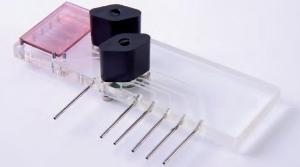Jun 28 2010
Imec’s research center at Belgium has demonstrated the operation of biosensors that facilitate the identification of certain disease markers of extremely low concentrations. These biosensors are based on new nanostructure patterns that are capable of increased sensitivity, reliability and specificity.
The sensor incorporates functionalized nanoparticles that allow for the detection of diseases such as cancer at early stages by identifying markers or specific molecules even when they are present in low density in the human blood. The nanoparticles can also work by binding with diseased cells and destroying them to help cure the disease, thus providing an improved and cost-effective means of healthcare. Detection systems developed based on this technology can also be extended to biosensing multiple parameters.

This nanoparticle-based biosensor technology leverages the localized surface plasmon resonance phenomenon exhibited by nanostructures of noble metals such as silver and gold. The sensing is based on optical identification of a difference in spectral response of the nanostructures of these metals when they affix themselves to a disease marker. Greater sensitivity can be achieved by varying the size and morphology of the nanostructures of noble metals.
The Imec research center has developed broken-symmetry gold nanostructures in which nanodiscs and nanorings are integrated in close proximity. This method facilitates intricate designing of the plasmon resonance phenomenon displayed by the nanostructures, by optimizing the width of the resonance shift and the resonance peak when the disease marker binds with the human cell. Such geometries demonstrate better performance when practically used in sensitive biosensors compared to traditional nanospheres. In this research, the Imec center has collaborated with Imperial College, London, Rice University, Houston, and the Catholic University of Leuven.
Prof. Liesbet Lagae, who manages the HUMAN++ on biomolecular interfacing technology program at Imec, said that the company aims at aiding the pharmaceutical and disease diagnostics industry by providing instruments to develop more cost-effective therapies and diagnostic systems enabled by bio-nano research.